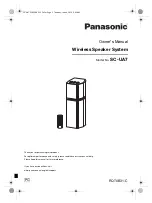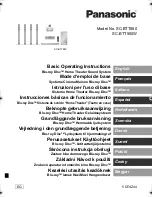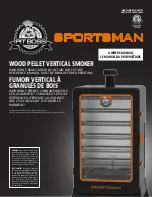
13
English
Full Range Operation
Another significant advantage of MartinLogan’s exclusive trans-
ducer technology reveals itself when you look at examples of
other loudspeaker products on the market today. MartinLogan
electrostats uses no crossover networks in critical frequency
ranges because they are not needed. The single, seamless
electrostatic membrane reproduces all frequencies above the
single crossover point. How is this possible?
First we must understand that music is not composed of separate
high, mid and low frequencies. In fact, music is comprised of a
single waveform with all frequencies interacting simultaneously.
The electrostatic transducer of the speaker essentially acts as
an exact opposite of the microphones used to record the origi-
nal event. A microphone, which is a single working element,
transforms acoustic energy into an electrical signal that can be
amplified or preserved by some type of storage media. The
speaker’s electrostatic transducer transforms electrical energy
from your amplifier back into acoustical energy.
Due to the limitations of electromagnetic drivers, no single
unit can reproduce the full range of frequencies. Instead, these
drivers must be designed to operate within a narrow, fixed
bandwidth of the frequency range, and then combined electri-
cally so that the sum of the parts equals the total signal. While
nice in theory, we must deal with real-world conditions.
In order to use multiple drivers, a crossover network is enlist-
ed to attempt a division of the complex musical signal into
the separate pieces (usually highs, mids, and lows) that each
specific driver was designed to handle. Unfortunately, due
to the phase relationships that occur within all crossover net-
works and during the acoustical recombination process,
nonlinearities and severe degradation of the music signal take
place in the ear’s most critical zone.
The speaker’s electrostatic transducer can single-handedly
reproduce all frequencies above the crossover point simulta-
neously. You have in one transducer the ability to handle in
elegant simplicity the critical frequencies.
The crossover phase aberrations that are associated with tradi-
tional tweeter, midrange, and woofer systems are eliminated.
The result is a dramatic improvement in imaging and staging
performance due to the minutely accurate phase relationship
of the full-range panel wave launch.
Critical Zone
Conventional Loudspeaker
Tweeter
Midrange
Woofer
crossover point (100–400 Hz)
crossover point (2,000–5,000 Hz)
MartinLogan Classic ESL 9
crossover point (400 Hz)
Woofer
ESL
Panel
This diagram illustrates how a conventional speaker
system must use multiple crossover networks that
have negative effects on the musical performance.
Summary of Contents for classic ESL 9
Page 1: ......
Page 2: ......
Page 3: ......
Page 4: ......
Page 5: ...u s e r s m a n u a l m a n u e l d e l u t i l i s a t e u r...
Page 8: ......
Page 10: ......
Page 12: ...12...
Page 13: ...x1 x4...
Page 33: ......
Page 34: ...15 38cm 59 8 152cm 0 10 4 26 4cm 9 3 23 6cm 34Hz 23kHz 3dB 78 lbs 35 4 kg 4 Ohms 90dB 2 83 V M...
Page 35: ...6 2 15 8cm 4 4 11 3cm 7 6 19 2cm 25 1 63 7cm 25 4 64 6cm 0 5 0 0...
Page 36: ...2x x 24 61cm 24 61cm x...
Page 37: ......
Page 38: ...Classic ESL 9 50 400W 4 Ohms...
Page 39: ......
Page 40: ......
Page 41: ...u s e r s m a n u a l English...
Page 42: ...42...
Page 48: ...6 English 2x x 24 61cm 24 61cm x Final placement...
Page 49: ...7 Flashlight toe in technique English...
Page 66: ......
Page 67: ...m a n u e l d e l u t i l i s a t e u r Fran ais...
Page 68: ...26...
Page 74: ...32 Fran ais 2x x 24 po 61cm 24 po 61cm x Positionnement final...
Page 75: ...33 Technique d orientation la lampe de poche Fran ais...
















































